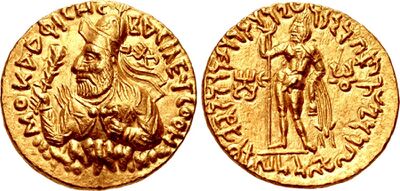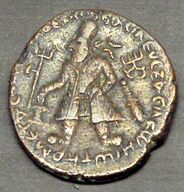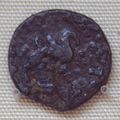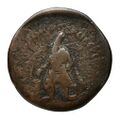ڤيما كادفيسس
| ڤيما كادفيسس Vima Kadphises | |
|---|---|
| امبراطور الكوشان | |
 Double stater Vima Kadphises. Obverse: diademed and crowned figure of Vima Kadphises seated facing on stool with ornate legs, head left, feet on footstool, holding laurel branch in raised right hand. Corrupted Greek language legend: ΒΑΣΙΛΕΥΣ ΟΟΗΜΟ ΚΑΔΦΙϹΗϹ ("Basileus Ooimo Kadphisis"): "King Vima Kadphises". Afghanistan. Guimet Museum, MG24356 | |
| العهد | 113–127 م |
| سبقه | ڤيما تاكتو |
| تبعه | كانيشكا |
| الأسرة المالكة | الكوشان |
| الديانة | البوذية[1] |
Maharaja rajatiraja devaputra
Kushanaputra (Shahi Vamataksha) masya
Vakanapatina Huma (devakulu) karita
متحف متهرا.
ڤيما كادفيسس (لغة الكوشان: Οοημο Καδφισης؛ الصينية الوسيطة المبكرة: 阎膏珍 وتُنطق jiam-kaw-trin ؛ إنگليزية: Vima Kadphises) كان امبراطوراً على الكوشان من حوالي 90–100 م. وحسب نقش رباطك، فقد كان ابن ڤيما تاكتو ووالد كانيشكا.
الحكم
وسـَّع الامبراطور ڤيما كادفيسس أراضي الكوشان في أفغانستان وپاكستان وشمال غرب الهند.
النسب
The connection of Vima Kadphises with other Kushan rulers is described in the Rabatak inscription, which Kanishka wrote. Kanishka makes the list of the kings who ruled up to his time: Kujula Kadphises as his great-grandfather, Vima Taktu as his grandfather, Vima Kadphises as his father, and himself Kanishka:
"... for King Kujula Kadphises (his) great grandfather, and for King Vima Taktu (his) grandfather, and for King Vima Kadphises (his) father, and *also for himself, King Kanishka" (Cribb and Sims-Williams 1995/6: 80) Emperor Vima Kadphises expanded the Kushan territory in Afghanistan and north-west India, where he may have replaced the Indo-Scythian ruler Sodasa in Mathura.
العملات
| أباطرة الكوشان 30 م–350 م | ||||||||||||||||||||||||||||||
|---|---|---|---|---|---|---|---|---|---|---|---|---|---|---|---|---|---|---|---|---|---|---|---|---|---|---|---|---|---|---|
|
||||||||||||||||||||||||||||||
He was the Kushan emperor to first introduce gold coinage, in addition to the existing copper and silver coinage. Most of the gold seems to have been obtained through trade with the Roman Empire. The gold weight standard of approximately eight grams corresponds to that of Roman coins of the 1st century. Gold bullion from Rome would be melted and used for the Kushan mints, into three denominations: the double stater, the stater, and the quarter starter (or dinara).
استخدام الذهب يشهد على الرخاء الذي كانت تعيشة إمبراطورية الكوشان من زمن ڤيما، being the center of trade between the أسرة هان في الصين (حيث كان ڤيما يُعرف بإسم 阎膏珍)، آسيا الوسطى and Alexandria and Antioch in the West. The Kushan were able to maintain and protect the طريق الحرير، allowing silk, spices, textiles or medicine[بحاجة لمصدر] to move between China, India and the West. In particular, many goods[vague] were sent by ship to the Roman empire, creating a return flow of gold coins, Greek[vague] wine and slaves. Works of arts were also imported from all directions[أين؟][vague], as indicated by the variety and quality of the artefacts[vague] found in the Kushan summer capital of Bagram in Afghanistan. A strong artistic syncretism was stimulated, as indicated by the Greco-Buddhist art of Gandhara.
Roman history relates the visit of ambassadors from the Indian kings to the court of Trajan (98–117 CE), bearing presents and letters in Greek, which were sent either by ڤيما كادفيسس أو ابنه كانيشكا.
Most of Vima's coins feature the Buddhist symbol of the Triratana on the reverse (or possibly Shiva's symbol for Nandi, the Nandipada), together with Hindu representations of Shiva, with or without his bull. Often time, a Trishul is depicted مع شيڤا.
Obv: Bust of king emerging from a cloud, with a crested helmet and holding a club. Corrupted Greek language legend: ΒΑΣΙΛΕΥΣ ΟΟΗΜΟ ΚΑΔΦΙΣΗΣ ("Basileus Ooimo Kadphisis"): "King Vima Kadphises".
Rev: Shiva, with a long trident in right hand, and the skin of a tiger in the left. Left, monogram of Vima Kadphises. Right: Buddhist triratna symbol (or possibly Nandipada). Kharoshthi legend: MAHARAJASA RAJADIRAJASA SARVALOGA ISVARASA MAHISVARASA VIMA KATHPHISASA TRADARA "The Great king, the king of kings, lord of the World, the Mahisvara (lord of the earth), Vima Kathphisa, the defender."
أنواع العملات
| سبقه ڤيما تاكتو |
حاكم الكوشان 90 – 100 م |
تبعه كانيشكا |
الهامش
- ^ (PDF) https://edoc.ub.uni-muenchen.de/26560/1/Albery_Henry.pdf.
{{cite web}}: Missing or empty|title=(help) - ^ Revire, Nicolas (January 2017). "Kinsman of the Sun: An Early Buddha Image in the Asian Art Museum, Berlin, and Solar Symbolism". Indo-Asiatische Zeitschrift, Vol. 20-21, Pp. 3-14 (in الإنجليزية): 9.
- ^ Banerjee, Gauranga Nath (1920). Hellenism in ancient India. Calcutta : Published by the Author ; New York : Oxford University Press. p. 92.
المراجع
- Hill, John E. (2009) Through the Jade Gate to Rome: A Study of the Silk Routes during the Later Han Dynasty, 1st to 2nd Centuries CE. BookSurge, Charleston, South Carolina. ISBN 978-1-4392-2134-1.
- Tarn, W. W. (1951). The Greeks in Bactria and India. 3rd Edition 1984. Ares Publishers, Chicago. ISBN 0-89005-524-6
وصلات خارجية
- CS1 errors: missing title
- CS1 errors: bare URL
- Short description is different from Wikidata
- Pages using multiple image with auto scaled images
- Articles containing إنگليزية-language text
- Pages using Lang-xx templates
- Articles with unsourced statements from April 2010
- All Wikipedia articles needing clarification
- Wikipedia articles needing clarification from April 2010
- نطاق جغرافي مبهم from July 2011
- امبراطورية كوشان
- ملوك القرن الثاني في آسيا

















